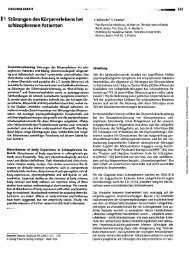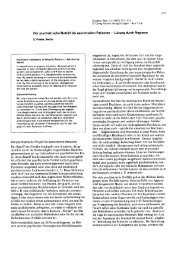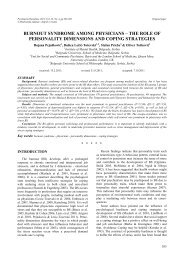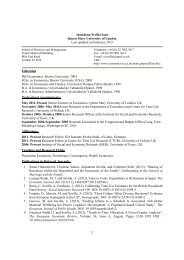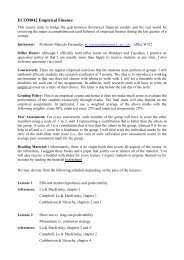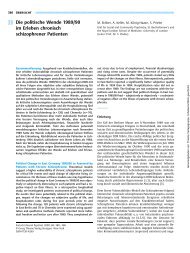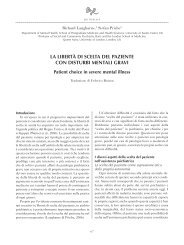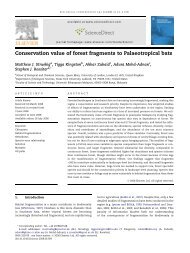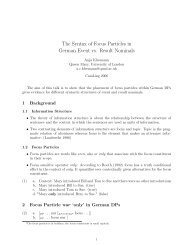Proofs - Personal Webspace for QMUL - Queen Mary, University of ...
Proofs - Personal Webspace for QMUL - Queen Mary, University of ...
Proofs - Personal Webspace for QMUL - Queen Mary, University of ...
Create successful ePaper yourself
Turn your PDF publications into a flip-book with our unique Google optimized e-Paper software.
to Kleinman, explanatory models consist <strong>of</strong> the illness and<br />
disease concepts <strong>of</strong> a single person in a given illness episode<br />
in interaction with his/her cultural context and socio- cultural<br />
environment (e.g. caregivers including experts, family members<br />
etc.).<br />
The research by Williams & Healy, 2001 [41] suggests to<br />
apply the term “explanatory map” as an alternative to “explanatory<br />
model”, because the term “map” refl ects the diversity and<br />
complexity that can be found in conceptions <strong>of</strong> illness and<br />
disease [41]. That implies that “explanatory models” do not<br />
consist <strong>of</strong> a coherent set <strong>of</strong> beliefs, but a multiplicity <strong>of</strong> illness<br />
and disease explanations constructed in specifi c socio- cultural<br />
settings, which may be infl uenced by time and “historical development<br />
<strong>of</strong> traditional cultural knowledge” [33,4].<br />
It has been suggested that the way patients feel to be understood<br />
and accepted in the process <strong>of</strong> treatment has an important<br />
infl uence on the compliance and the experience <strong>of</strong> therapeutic<br />
relationships [26,5,18,35]. Explanatory models and concepts<br />
also play an important role in terms <strong>of</strong> beliefs and estimations<br />
<strong>of</strong> the social consequences <strong>of</strong> a disease and the social role <strong>of</strong> a<br />
patient. This can include aspects <strong>of</strong> social stigmatisation and<br />
ideas about the participation <strong>of</strong> the patient in social life or the<br />
working environment [9].<br />
In the African context, illness is very <strong>of</strong>ten regarded as a family<br />
affair, i.e. a collective experience <strong>of</strong> different subjects [32]. The<br />
infl uence <strong>of</strong> cultural knowledge (social rules, rituals, traditions,<br />
symbolisation, communication styles) and (collective) narratives<br />
thus plays an important role in the constructions <strong>of</strong> “explanatory<br />
models” or “explanatory maps”.<br />
Research on explanatory models <strong>of</strong> schizophrenia in Afríca<br />
is complicated by the history <strong>of</strong> psychiatric explanations <strong>of</strong><br />
psychosis. For example, Bleuler termed the word “schizophrenia”<br />
when closely cooperating with Freud, and assumed that<br />
schizophrenic thought disorder refl ects a loss <strong>of</strong> evolutionarily<br />
higher cognitive functions and a return to a “primitive” mode<br />
<strong>of</strong> wishful (autistic) thinking that characterizes both children<br />
and “the Negro” (in singular! ) [2]. Bleuler suggested that ideas<br />
in the mind are normally connected in a logical way and this<br />
connection is en<strong>for</strong>ced by the experience <strong>of</strong> ‘reality’. He claimed<br />
that a pathological destruction <strong>of</strong> the connections can lead into<br />
psychosis. If the logical connections between ideas are lost,<br />
the psyche splits up into incoherent ideas, and the only <strong>for</strong>ce<br />
which regulates their manifestation is desire. This split up <strong>of</strong><br />
the mental process gave the disease its new name – schizophrenia<br />
[15]. During colonialism, Western psychiatrists claimed<br />
that healthy Africans resemble Europeans after lobotomy (a<br />
destruction <strong>of</strong> prefrontal cortex function), which was supposed<br />
to explain symptomatic differences in mental disorders between<br />
Europeans and Africans [6]. However, in the 1950ies and 60ies,<br />
the “race” concept was increasingly rejected, because it wrongly<br />
assumes categorical genetic differences between populations<br />
when indeed only gradual differences in allele frequencies are<br />
observed [27]. In psychiatry, Lambo showed that differences in<br />
psychotic symptoms in Nigerian patients are strongly infl uenced<br />
by their individual upbringing, with subjects from traditional<br />
backgrounds displaying mainly polymorphic psychoses and<br />
subjects with Westernized socialisations reporting “classical”<br />
key symptoms <strong>of</strong> schizophrenia such as certain acustic hallucinations<br />
or passivity phenomena [24,37]. Using such symptoms<br />
F. Napo et al. / European Psychiatry 27 (2012) / supplement n°2 / S44-S49 S45<br />
as diagnostic criteria, the World Health Organization later<br />
observed comparable frequencies <strong>of</strong> schizophrenia in different<br />
countries around the world, including Nigeria [36]. While these<br />
data falsify hypothesis that suggest fundamental differences in<br />
mental disorders between Africans and Europeans, cultural and<br />
religious differences in e.g. concepts <strong>of</strong> “the soul”, “the self” or<br />
the existence <strong>of</strong> supernatural beings and their impact on human<br />
life and experience may cause pr<strong>of</strong>ound differences in illness<br />
experience.<br />
There<strong>for</strong>e, the goal <strong>of</strong> our study was 1) to assess key<br />
psychotic symptoms and explanatory models/maps <strong>of</strong> West<br />
African patients and their caregivers, and 2) to investigate how<br />
psychotic patients are treated in a Malian community- orientated<br />
psychiatric context. We tried to focus not only on symptoms<br />
and impairments but to also assess how salutogenetic resources<br />
<strong>of</strong> the patients are taken into consideration in local treatment<br />
settings [1].<br />
2. The setting<br />
Our investigation was based in the Department <strong>of</strong> Psychiatry<br />
<strong>of</strong> the <strong>University</strong> Hospital, Point G, in Bamako, Mali. The inpatient<br />
service is organized as a communal treatment setting. Since the<br />
1980ies, a re<strong>for</strong>m movement in Mali has focused on changing<br />
the classical view and associated stereotypes <strong>of</strong> psychiatric treatment<br />
[23]. This movement is interested in minimizing social<br />
stigmatisation and tries to give patients a voice to integrate the<br />
families into the therapeutic process, and to facilitate reintegration<br />
into society. The movement intends to overcome treatment<br />
models in which patients are isolated from their social reality,<br />
placed in the passive role <strong>of</strong> an “ill patient” and treated nearly<br />
exclusively with medication [23].<br />
In 1984, the Ministry <strong>of</strong> Health developed treatment guidelines<br />
including the demand <strong>for</strong> an amelioration <strong>of</strong> treatment<br />
conditions. Since then, patients who are treated in the so- called<br />
“psychiatric village” at the <strong>University</strong> Hospital in Bamako are<br />
only admitted when accompanied by a family member [10]. The<br />
family and patients live together in small houses on the compound<br />
and they share the social reality <strong>of</strong> the patient during the<br />
whole therapeutic process. The patient and his/ her companion<br />
live together, cook together and sleep in the same house, similar<br />
to their home environment.<br />
The centre <strong>of</strong> the therapeutic village is the “Toguna”, a small<br />
round house where the experts hold clinical consultations with<br />
the patients and their families. The architecture <strong>of</strong> the small<br />
house has a therapeutic meaning: on the one hand the “Toguna”<br />
is constructed in a round <strong>for</strong>m to include all pr<strong>of</strong>essionals, relatives<br />
and patients during the consultation, and the “Toguna” has<br />
a very low ceiling. Thus, a person who becomes angry during<br />
the expert consultation is not able to stand up, which, in the<br />
experts’opinion, calms the anger <strong>of</strong> the person and suppresses<br />
aggression.<br />
A patient’s companion can play an important (salutogenic)<br />
role <strong>for</strong> the healing process. The family member who accompanies<br />
the patients during the whole therapeutic process acts as<br />
a mediator. The role <strong>of</strong> the mediator is to clear the way <strong>for</strong> the<br />
communication between the experiences <strong>of</strong> the patient and the<br />
socio- culturally constructed realities <strong>of</strong> the family members.<br />
<strong>Pro<strong>of</strong>s</strong><br />
08_Napo.indd S45 14/06/2012 14:44:50




